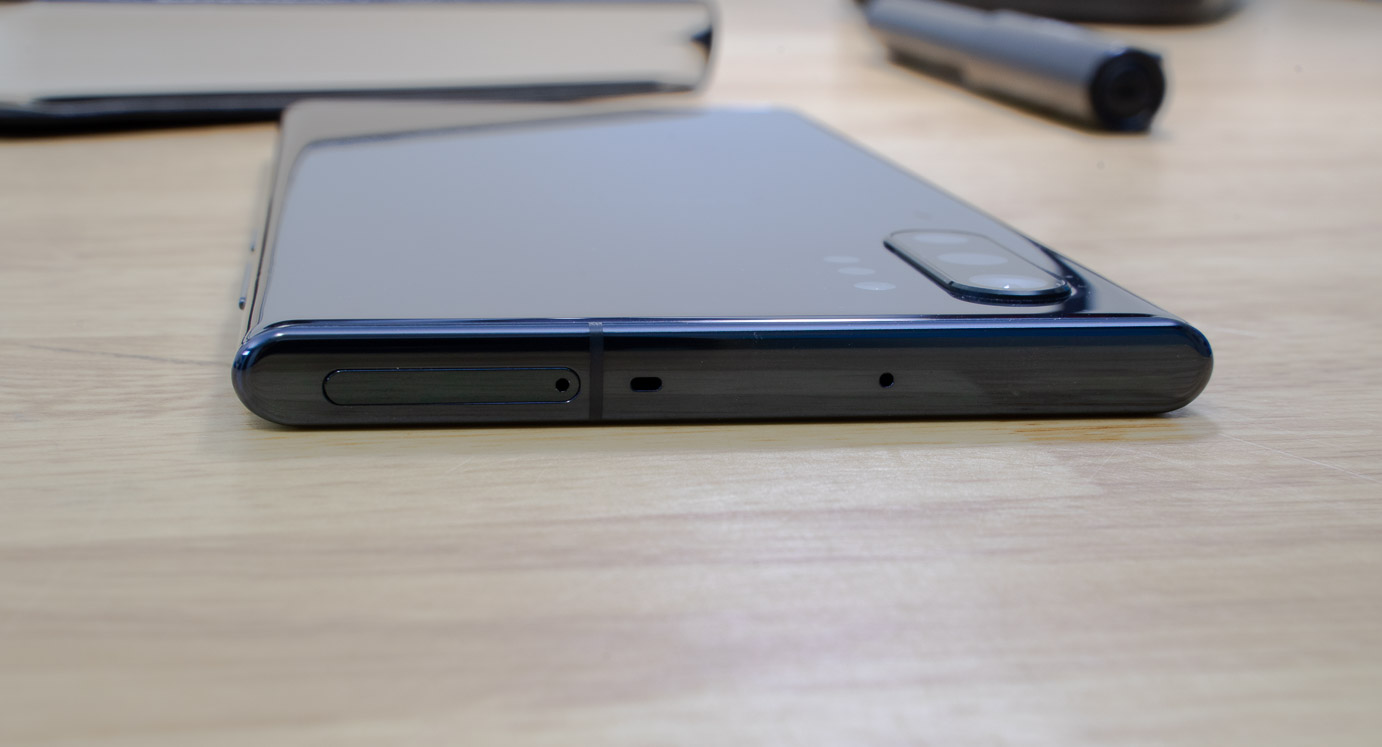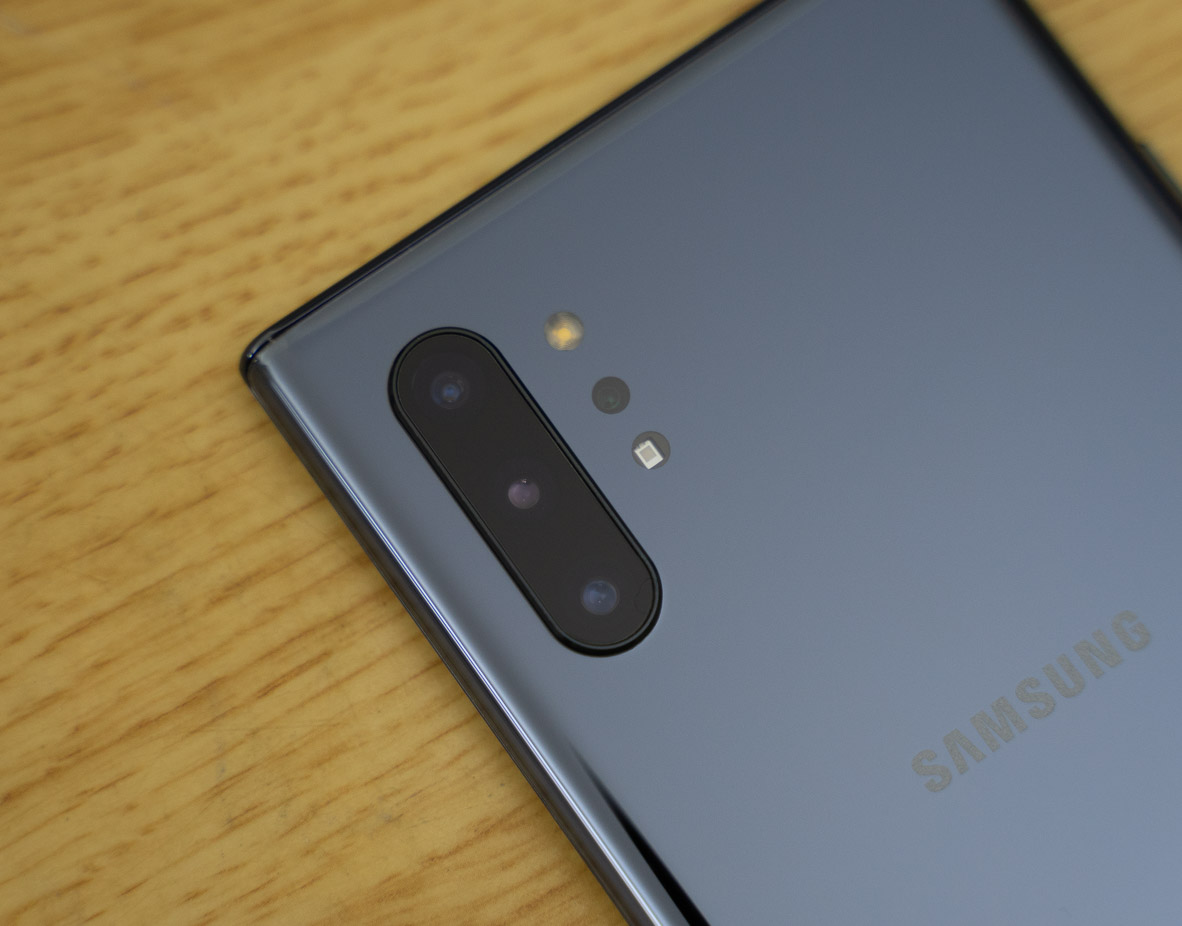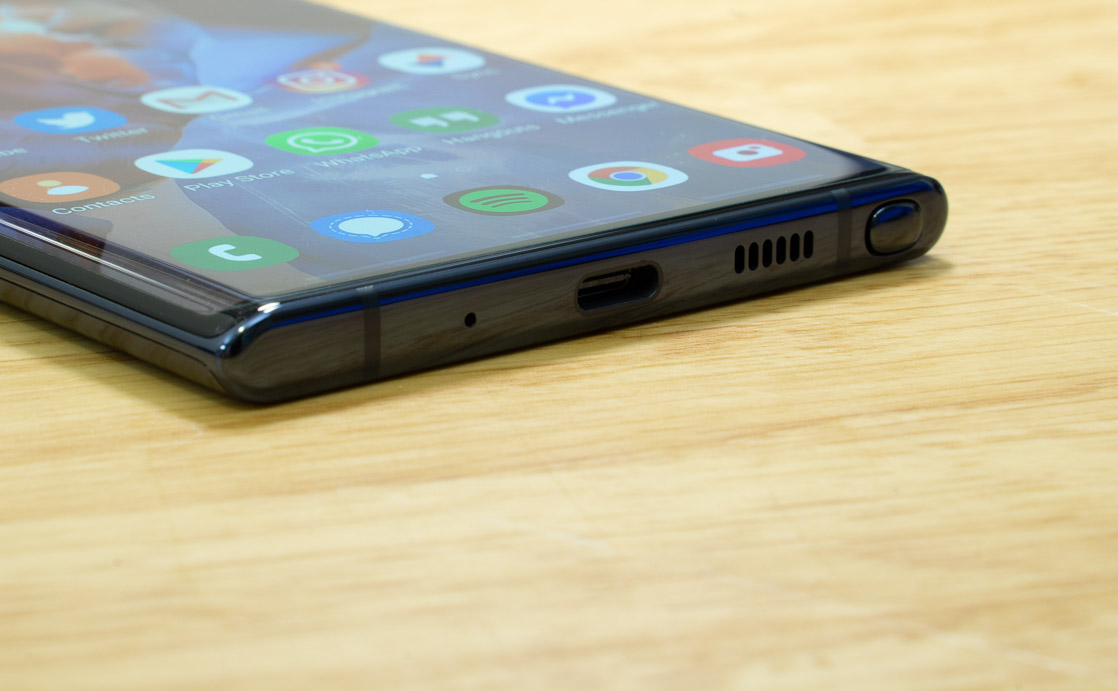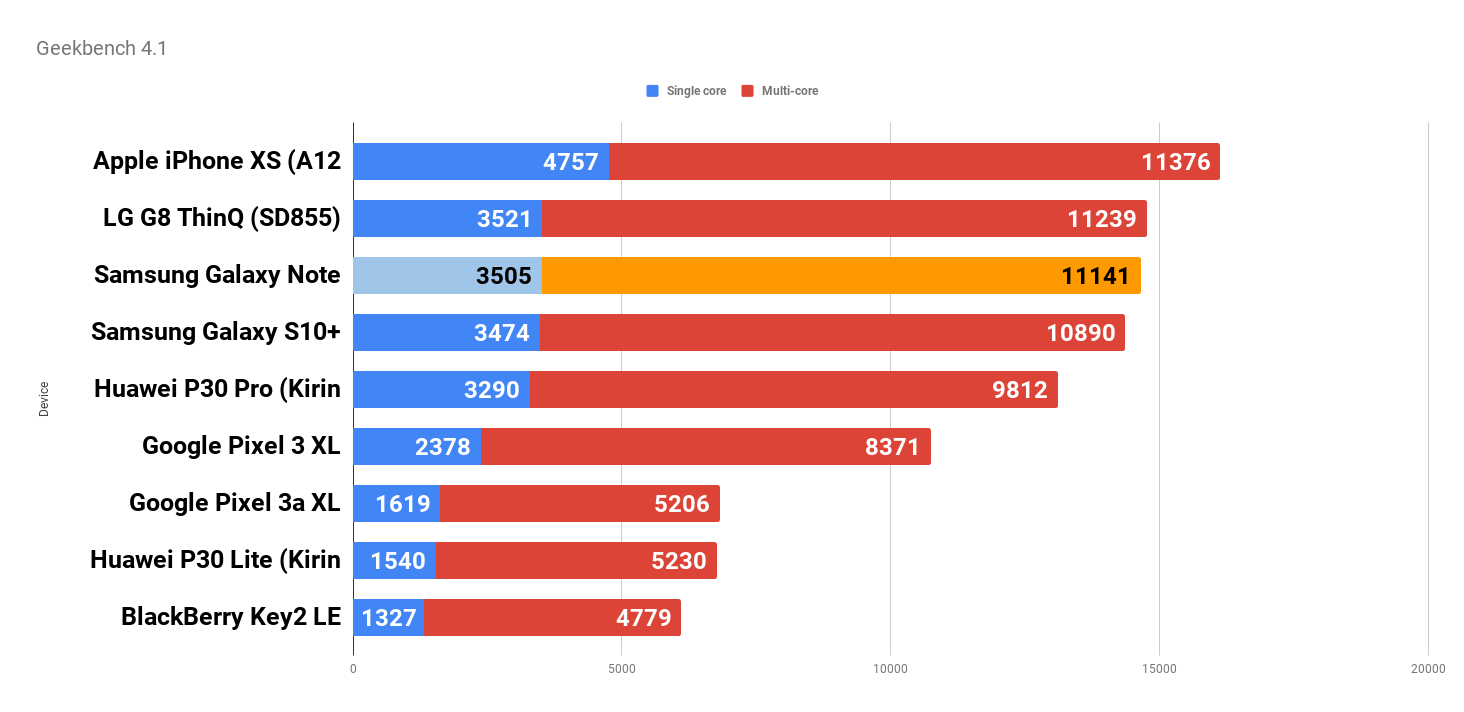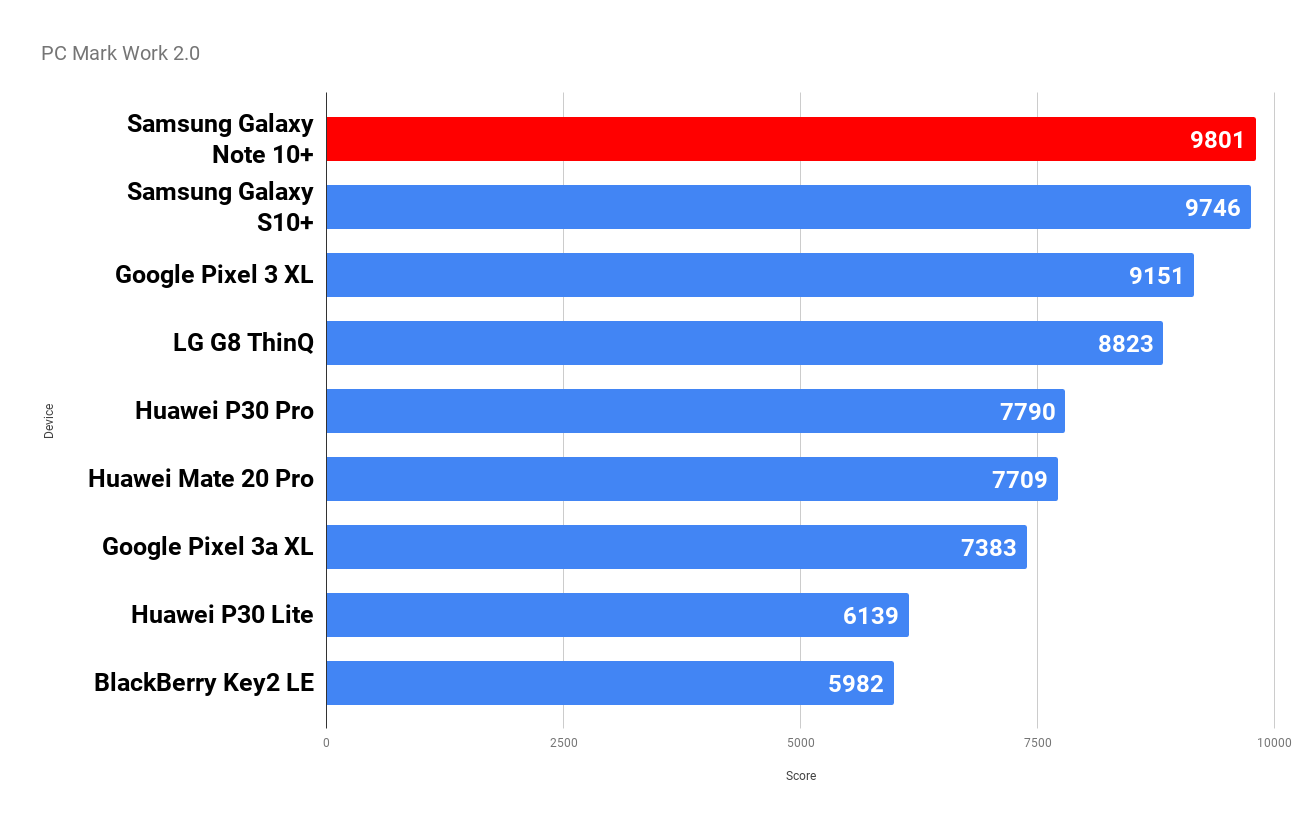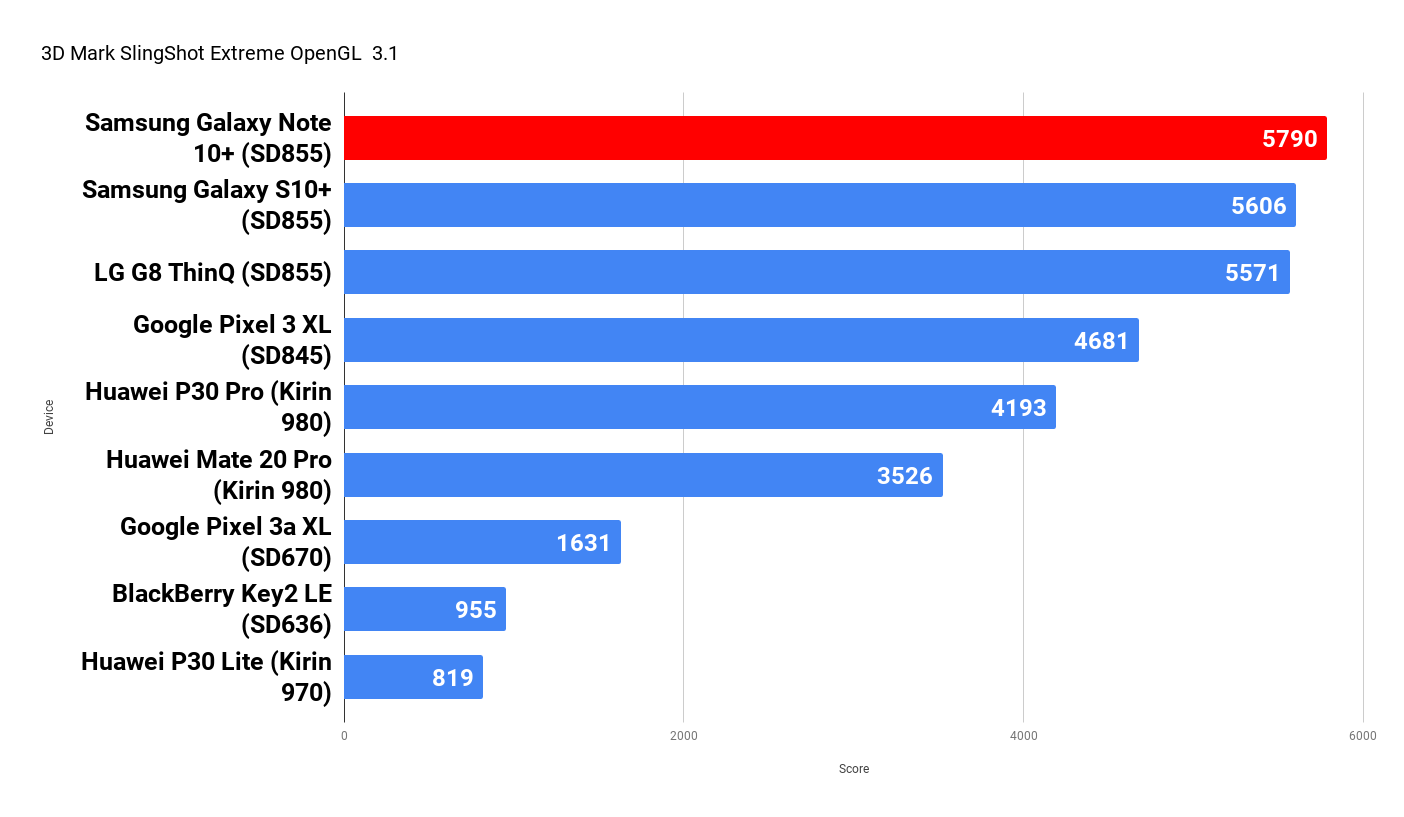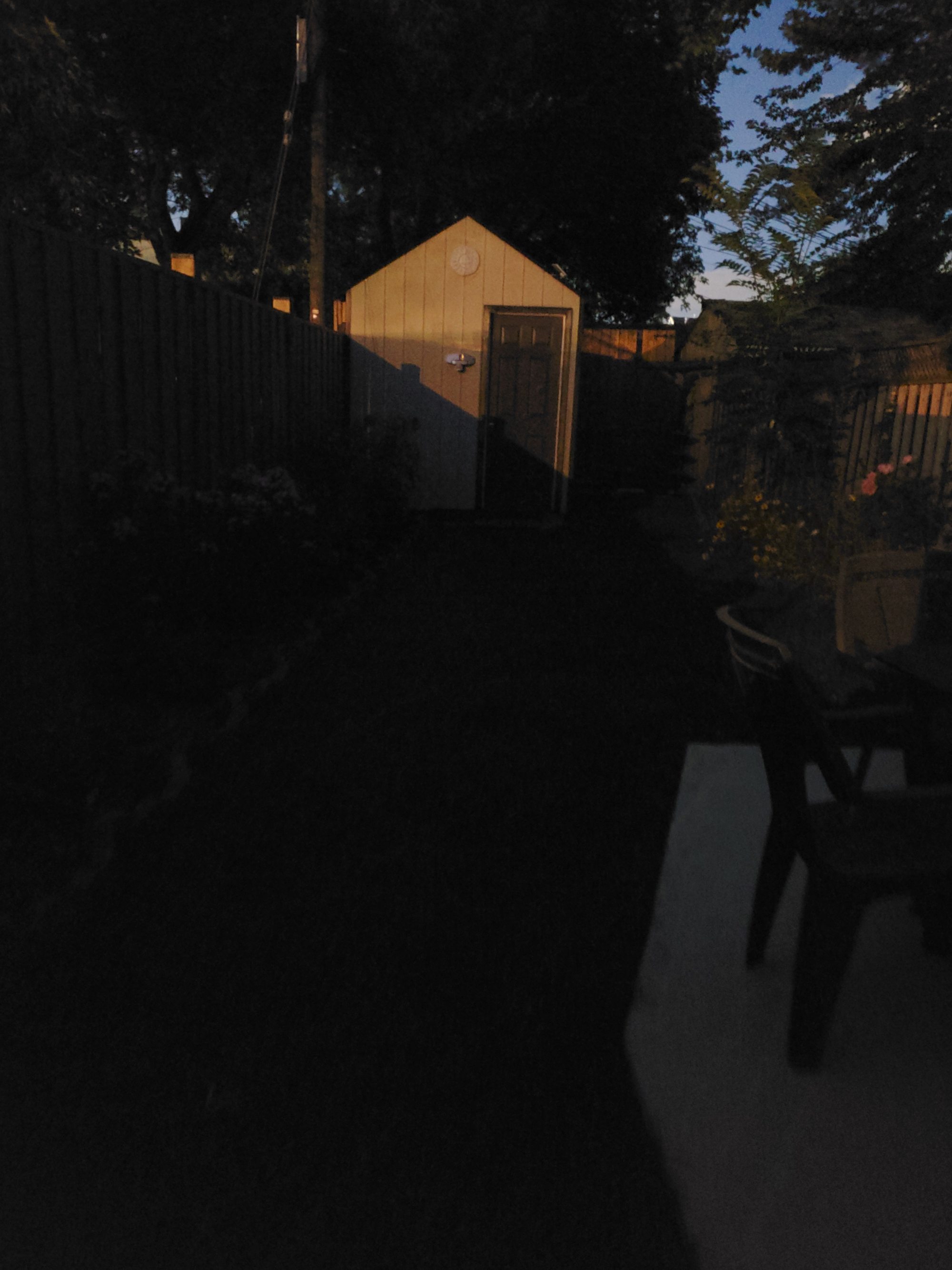| The Galaxy Note 10+ touts several significant improvements over the Galaxy Note 9, bringing with it a larger battery, improved pen, larger battery, a new camera system, and faster hardware. Samsung’s Super Fast 45W charging is also a much-welcomed feature. With that said, the still-excellent Note 9 can hold off for another year, especially given the Note 10+’s $1,459 starting price. Users can also opt for the smaller 6.3″ Note 10 at the expense of an inferior camera system and a smaller 3,500mAh battery for $210 less. If you’re a loyal Note user, check your wallet before buying: you’ll love it if you can afford it, but there isn’t a pressing need to upgrade just yet. | |
Pros:
|
Cons:
|
Samsung Galaxy Note 10+ specifications
| Galaxy Note 10+ | Galaxy Note 10 | Galaxy Note 9 | |
| Display size | 6.8” QHD+ Dynamic AMOLED 3,040×1,440 | 6.3” Dynamic AMOLED 2,280×1,080p | 6.4” Dynamic AMOLED 2,960×1440 |
| Chipset | Qualcomm Snapdragon 855 | Qualcomm Snapdragon 845 | |
| RAM | 12GB | 8GB | 6GB/8GB |
| Storage | 256GB / 512GB | 256GB | 256GB / 512GB |
| Camera | 12MP Wide-angle
12MP Telephoto 16MP Ultra-wide angle ToF sensor |
12MP Wide-angle
12MP Telephoto 16MP Ultra-wide angle |
12MP Wide-angle
12MP Telephoto |
| Battery | 4,300mAh | 3,500mAh | 4,000mAh |
| Dimensions | 162.2mm x 77.2mm x 7.9mm | 151.9 x 71.8mm x 7.9mm | 161.9mm x 76.4mm x 8.8mm |
| Durability | IP68 | IP68 | IP68 |
| Weight | 198g | 168g | 201g |
| Price | Starting at $1,469.99 | Starting at $1,259.99 | Starting at $1,299.99 |
Design
Standing at 162mm tall and 77.2mm wide, the Note 10+ is a behemoth of a phone and is hostile to shallow pockets and small hands alike. Its glossy, slippery glass back also begs for a case not just to enhance grip, but utility as well. More on that later.
With the Bixby button gone, only the power button and the volume rocker populate the bezels. Samsung’s famous Infinity-O display makes a return, and with it, the beautiful but sometimes irksome curved display.
The top bezel holds the microphone array and the dual-slot SIM tray. The second SIM slot accepts either a second SIM card or a microSD card.
The single punch-hole camera has been moved to the center for a more natural angle. It also takes up less space for a more immersive viewing experience. Also, notice that the earpiece has been completely tucked away behind the glass, leaving only a nearly-invisible slit to vent out sound.
A glance at the camera array reveals both old and new hardware. The camera array was ported directly from the Galaxy S10+, featuring the same 16MP wide-angle camera, 12MP ultra-wide camera, and a 12MP zoom camera. Next to it is a brand new Time-of-Flight (ToF) depth sensor.
Here’s why a case is mandatory. The protruding camera bump causes the phone to wobble when resting flat, effectively rendering it unusable for notetaking. If you’re looking to use the Note 10+ to write or draw in any capacity, make sure to wrap it in a case.
The S Pen is the star of the show. It smoothly slots into the bottom and locks in place with a spring-loaded button.

At the bottom is another microphone, a USB-C port, and a single base firing speaker. Sound quality is crystal clear, but isn’t very loud. In case you haven’t noticed yet, the headphone jack is missing this time around.
Display
The Note 10+ has the same Dynamic AMOLED panel as the Galaxy S10+. Ambitiously named the Infinity display, the 6.8” screen features a 3,040 x 1,440p resolution (498 PPI) and is HDR10+ certified. You’ll have to manually set the resolution to 1,440p, though, as the default resolution is set at 1080p to conserve battery.
The Infinity display truly lives up to its name. Now that Samsung has perfected its punch-hole front camera, it’s able to file down the top bezel to near-nothingness, creating a front that’s all display. While a slight chin protrudes from the base, I still think it’s apt to call it edge-to-edge.
In terms of performance, the Dynamic AMOLED display sits on the throne of smartphone displays. Not only are its colors down-right eye-watering, it’s also crazy bright, capable of up to 1,200 nit peak brightness. And although all OLED displays have deep blacks, the supremely high brightness definitively enhances contrast, and is a critical component of the HDR10+ certification. I extensively talked about the prowess of the Dynamic AMOLED display in our Samsung Galaxy S10+ review.
One downside to the Infinity display is its curved edge. Since there’s almost no bezel and the glass is curved, it’s quite easy for the palm to accidentally to swipe the edge. This problem frequently occurs when you’re trying to control elements using your thumb. A screen with a flat edge would mitigate this issue.
Another off-putting design choice is the pre-installed screen protector. I’ve stated it in my S10+ review and I’m restating it here. Yes, I understand that many users will be quick to install one after purchase anyway, but Corning’s Gorilla Glass 6 is plainly superior and is part of the experience (at least for the front), an experience that costs nearly two grand.
Performance
Poised as the end-all, be-all smartphone, the Note 10+ has the best of everything. In addition to the latest Qualcomm Snapdragon 855 chipset, it also carries 12GB of RAM and starts at 256GB of storage. The international version uses Samsung’s Exynos 9825 chipset.
Geekbench
Geekbench is a pure processor benchmark that tests its performance in compression, encryption, PDF rendering, and various other tasks that require more complex calculations.
Unsurprisingly, the Note 10+ performed on par with the other smartphones with the same chipset.
PC Mark Work 2.0
PCMark for Android is as real-world as synthetic benchmarks get. It runs the phone through a list of everyday business tasks include writing, web browsing, video editing, and photo editing.
Its performance is once again in line with the Galaxy S10+.
3D Mark SSE OpenGL
Having 12GB of RAM almost feels like an overkill. Nonetheless, the Galaxy S10+ easily handled all the apps I use in my daily routine. Having more RAM means more apps can restart from the background faster without needing to be reloaded from the main storage. It’s also helpful in memory-intensive apps like Lightroom mobile.
Camera
The camera system on the Note 10+ is identical to the Galaxy S10+, featuring the same 16MP wide-angle camera, 12MP ultra-wide camera, and a 12MP zoom camera. The cameras are now arranged vertically against the top right corner, perhaps to make room for some other component under the hood.
What is new to Samsung phones is the Time-of-Flight (ToF) sensor. The time of flight sensor shoots out a laser pulse and calculates the distance to an object based on the time it takes the laser pulse to be reflected. In smartphone camera systems, ToF sensors are used to scan objects in 3D, provide better facial recognition, and to enhance software bokeh.
Rear camera
Wide
In good lighting scenarios, the Note 10+’s camera is on par with the very best, boasting superb sharpness and excellent colors. It’s when lighting gets dim that it gets a bit interesting.
When I asked how the camera has been improved back at Samsung Unpacked, Samsung said most of it has been in the software and left it at that. When shooting in low-light, the Note 10+ has a half-second to one-second delay after trigger press depending on lighting quality. The pause help gather more light for a brighter, richer image–if you have steady hands. Disabling HDR mode can reduce the duration of the delay.
Ultra-wide
As always, barrel distortion is unavoidable on ultra-wide cameras. Image quality is supreme, though.
Zoom camera
Night Mode
I wasn’t expecting a performance gap between the S10+ and the Note 10+. After all, they employ the same sensors. But it seems like Night mode has been improved since the Galaxy S10+. While the sensors are the same, Samsung addressed many of the issues in the S10+’s software, notably the insane smoothing and the perplexing bloom effect in night mode. Details now appear a bit sharper.
Night mode doesn’t kick in all that much in dim lighting. In the shots below, it barely made a difference.
The difference starts to become apparent when the light levels touch the extremes. The brightness does expose additional detail, but it still trails behind other flagship phones like the Pixel 3 XL and the Huawei P30 Pro.
Front Camera
Instead of using two cameras, the Note 10+ uses just one ultra-wide angle 10MP camera on the front. Its placement has also been centered for a more natural shooting experience.

Software and features
Like the S10 family, the Note 10s use Samsung’s One UI. It offers a plethora of customization options, which you could spend quite some time tinkering.
With the Bixby button now gone, Bixby has migrated to the power button. Luckily, this feature can be toggled so that long-pressing the power button still turns your phone off.
Samsung has also migrated a few features from developer options to the standard settings menu, two of the most outstanding being animation speed reduction and install unknown apps. Given its powerful hardware, the phone shouldn’t be bogged down due to fancy animations. Turning on install unknown apps is useful for developers who sideload apps or have mandatory niche third-party apps.
In addition, it dedicates a full page to the S Pen. Air Motion is compatible with a host of other apps besides the camera. For example, you can air swipe left and right to navigate back and forth in Google Chrome, flip up to scroll up and vice versa.
The Note 10+ can also focus sound recording towards a specific part of a video, which can be helpful if you’re trying to cut through the noisy crowd to a get a good sound of the band onstage. It actually tucks one of the microphones behind the camera array.
Samsung DeX
Samsung’s DeX feature has been around since the Galaxy S8 era. The goal is to have the phone deliver a desktop environment complete, with keyboard and mouse support. Back when it first launched, it could only run when paired with an expensive dock. Two generations later, it has received support for Mac OS and Windows 7/10 as an application, requiring only a USB cable between the host and the device.
DeX’s advantage is allowing mobile apps to expand into multi-window and fullscreen, alleviating apps from the claustrophobic confinement of a phone’s display. The difference is palpable: working in Adobe Lightroom mobile and replying to Facebook Messenger using my laptop’s keyboard was far more efficient than flipping through them using my thumb. More importantly, DeX allowed me to directly transfer files and copy text between the desktop and the phone–a godsend if you frequently swap pictures from one device to another.
Despite massive leaps in performance and interface refinements, workflow in DeX still isn’t comparable to a fully-fledged operating system. Firstly, it’s less responsive than the native system. Secondly, since most apps are cloud-integrated and cross-platform anyway, you can perform most tasks through the desktop. Being able to access phone notifications is convenient, but it isn’t essential. And thirdly, DeX doesn’t play nice with keyboard shortcuts, frequently clashing with the host system.
The S Pen
Without the S Pen, the Galaxy Note+ would just be a glorified S10+. In the 10th iteration, the S Pen now includes an embedded gyroscope for motion sensing along with the Bluetooth camera trigger function. It’s still IP68 waterproof and can standby for 10 hours on a single charge.
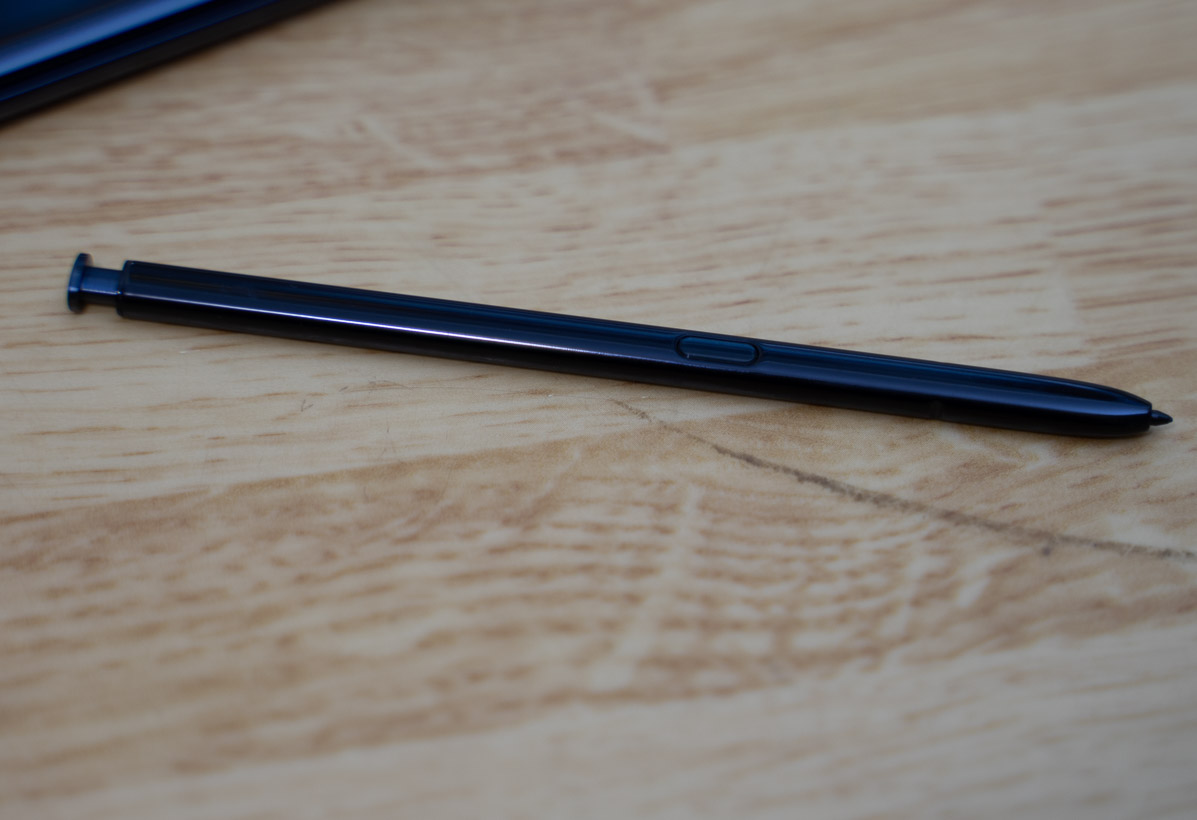
I’m often wary whenever I encounter gesture input because of their inconsistency. So queue my surprise when the S Pen’s Air Motion was not only consistent, but reliable. Being able to switch between shooting modes at the flick of the wrist should be handy for remote shooting and vloggers.
Outside of the camera, Air Motion can be used to control a host of other apps like page navigation in Google Chrome browser. Samsung has also released an SDK for developers to integrate Air Motion into their respective apps.
Even with 4,096 levels of pressure sensitivity and a fine 0.7mm tip, the S Pen still doesn’t feel as natural as pen and paper. Nonetheless, my artist friend had no problems creating details in the drawing below.

When it comes to note-taking, however, the screen is just a tad too small. Although the Note 10+ has a generous screen by smartphone standards, it’s tiny as a notebook. In my opinion, the note-taking aspect is better suited to the Galaxy Tab Android tablets. With that said, the handwriting-to-text capability was able to easily discern my chicken scratch handwriting, something even I have trouble with.
Furthermore, I found the S Pen to be invaluable for handwriting keyboards where you enter one character at a time. I frequently write in Chinese and prefer to use the handwriting tool as it just feels much more natural.
For when you accidentally stray too far from the pen, the phone will send out an alert to remind you to pick it up.
Battery life
With an immense 4,300mAh battery, it can take a while to fully drain the Note 10+ in a single day. Google’s Adaptive Battery feature baked into Android Pie is also fantastic at learning what apps to put into sleep. In my case, The Note 10+ was able to run for about 7 hours of screen-on time, carrying me through almost two full workdays.
Slow charging has been a blight of Samsung devices. The Samsung Galaxy S10+’s massive battery took nearly 1.5 hours to reach 100 per cent. The Note 10+ addresses this issue by introducing its Super Fast 45W charging that can bring its battery from 0 to 70 per cent in 30 minutes. Ideal, right?
Except Samsung doesn’t include a 45W Super Fast charger in the box and packs a 25W charger instead, meaning you’ll need to cough up extra cash for the privilege. The Super Fast charger also didn’t launch in parallel with the phone, so you can’t even buy it until September for an unknown sum.
Price and competition
If the S10+ is a flagship phone, then the Note 10+ can only be considered as a super flagship. As such, it starts at a ludicrous $1,459, rightfully reflecting its ultra-high-end features. For the price a premium laptop, you get a Qualcomm Snapdragon 855, 12GB of RAM, and 256GB of storage. It should be clear from its size, features, and pricing that this phone strictly targets the enthusiast crowd. In Canada, it’s available in Aura Black, Aura Glow, and Aura White color options.
What makes the Note 10+ such an outlier is, of course, its stylus. Because it stands alone in carrying one, an apples-to-apples competitor is none-existent. Since there’s no alternative from another brand, the conversation is then focused on whether Note 9 owners should upgrade.
The Galaxy Note 9 is more than a year old now, but it’s still holding up exceptionally. Its Snapdragon 845 and 6GB of RAM is still perfectly capable of keeping pace with today’s flagship phones. With that said, details like an in-screen fingerprint sensor, a better display, an improved S Pen, and a new camera system does make the Note 10+ feel like a compelling upgrade. Battery size got bumped by 300mAh, too.
For those that are looking for the smaller size, the smaller Note 10 can be had for $210 less. Unfortunately, the price cut also comes at the cost of a much smaller 3,500mAh battery, no ToF sensor, and perhaps less important, lower RAM. At this price, the pen-less Galaxy S10+ can start to feel like a better alternative, which is currently on sale for $1,269 and comes with 8GB RAM and 128GB of storage.
Conclusion
Turning a blind eye to the headphone jack, the Note 10+ is a fantastic device on all fronts. Most of its downsides — size, design, and so on — are purely subjective. I’m genuinely impressed with the camera improvements compared to the S10+ released just months ago. And now that it mitigates the slow charging issue, the well-rounded Note 10+ is suitable for power users and casual users alike.



